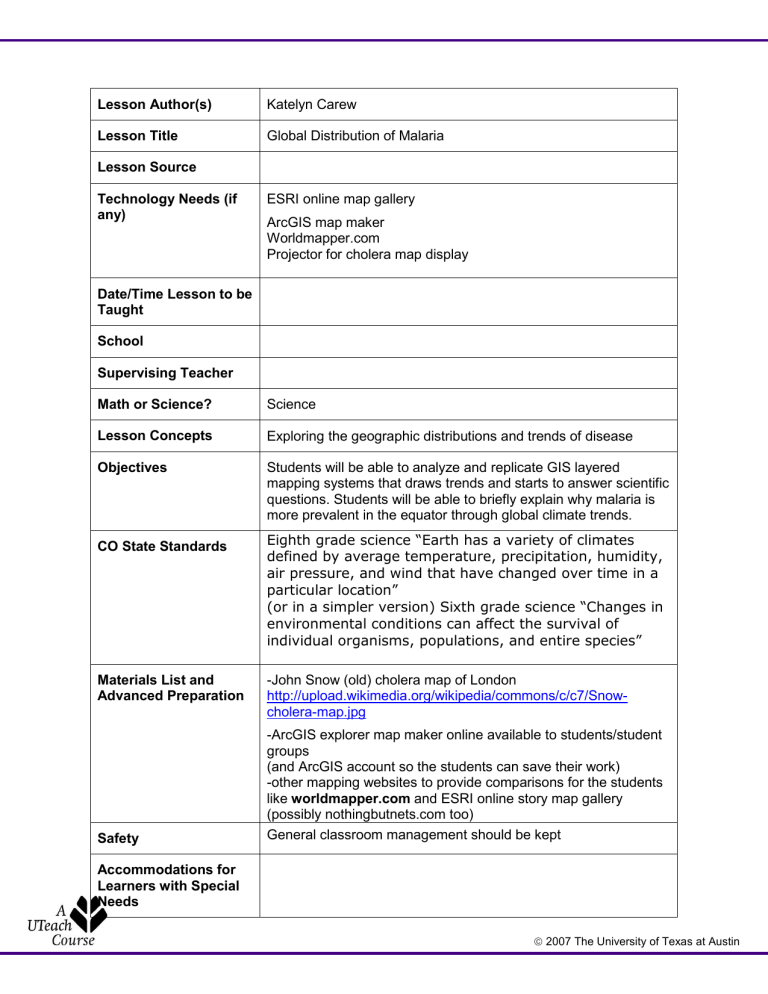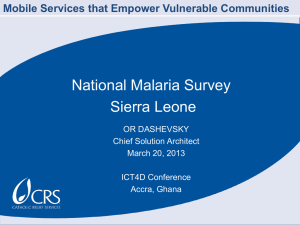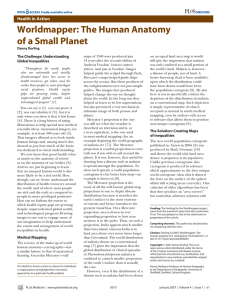Katelyn Carew Global Distribution of Malaria ESRI online map gallery

Lesson Author(s)
Lesson Title
Katelyn Carew
Global Distribution of Malaria
Lesson Source
Technology Needs (if any)
Date/Time Lesson to be
Taught
ESRI online map gallery
ArcGIS map maker
Worldmapper.com
Projector for cholera map display
School
Supervising Teacher
Math or Science? Science
Exploring the geographic distributions and trends of disease Lesson Concepts
Objectives
CO State Standards
Materials List and
Advanced Preparation
Safety
Accommodations for
Learners with Special
Needs
Students will be able to analyze and replicate GIS layered mapping systems that draws trends and starts to answer scientific questions. Students will be able to briefly explain why malaria is more prevalent in the equator through global climate trends.
Eighth grade science “Earth has a variety of climates defined by average temperature, precipitation, humidity, air pressure, and wind that have changed over time in a particular location”
(or in a simpler version) Sixth grade science “Changes in environmental conditions can affect the survival of individual organisms, populations, and entire species”
-John Snow (old) cholera map of London http://upload.wikimedia.org/wikipedia/commons/c/c7/Snowcholera-map.jpg
-ArcGIS explorer map maker online available to students/student groups
(and ArcGIS account so the students can save their work)
-other mapping websites to provide comparisons for the students like worldmapper.com
and ESRI online story map gallery
(possibly nothingbutnets.com too)
General classroom management should be kept
2007 The University of Texas at Austin
1. ENGAGEMENT
What the Teacher Will
Do
Probing/Eliciting Questions
The teacher will display on the projector an old map of cholera deaths in
London and simply pose the question to the students “What can you conclude about this map? What trends do you see?
” The students will write one significant observation on a small scrap of paper with their initials on it and place it in a communal bowl. The teacher will choose 1 or 2 responses from bowl at random and read them anonymously to the class and discuss the validity of the comment. (This puts responsibility on all the students without embarrassing anyone).
The teacher will then introduce the importance of maps and GIS systems in finding scientific trends
(especially when it comes to disease distribution). The teacher can also link this to a major disease of concern today: malaria.
What trends do you see on this map? What is this a map of?
What can you conclude? What scientific conclusions can you draw?
How can scientists use this type of data?
Evaluation/Decision Point Assessment
1 or 2 responses from select students read aloud in class would show where the students are at in regards to scientifically interpreting maps. Also, the teacher can read the rest of the responses after class as a form of preassessment.
Time: Minutes 10
Student Responses and
Misconceptions
Have trouble reading the small font on the map.
Reading the map more geographically than scientifically.
Student Outcomes
At least one comment on the map
Page 2 of 5
2. EXPLORATION
What the Teacher Will Do
The class will be split up into 3 or 4 groups. Each group will be assigned the open-ended scientific question “Where is malaria most prevalent in the world? Why is this?” Their job will be to research possible answers to this question and display the results they find in a
GIS layered map in ArcGIS online map maker. At this point the students should already be at least a little familiar with how to use ArcGIS. But if there is still confusion with how to display their results, the teacher will demonstrate with the question “Why are volcanos found where they are?” by overlaying a tectonic plate map with a map of all the world’s volcanos. After the groups are released, it is essential that the teacher walks around to clarify any misconceptions.
Probing/Eliciting
Questions
Where is malaria most prevalent in the world?
Why is this?
What are the climates like in these areas?
What organisms (some that may carry disease-mosquitos) live in these types of climates?
Is there a social aspect too to this question?
What is the poverty level in the areas of high concentration of Malaria?
What about the south of the US? They have a lot of mosquitos too. Why is malaria not prevalent there? What disease is prevalent in these areas that is carried by mosquitos?
Evaluation/Decision Point Assessment
Student involvement in their groups.
Time: Minutes 45
Student Responses and
Misconceptions
Students may focus too much on
Africa and forget to notice other countries along the equator that also has high concentrations of
Malaria.
Student Outcomes
Overlaid maps that can be easily interpreted.
Page 3 of 5
3. EXPLANATION
What the Teacher Will Do
Near the end of their activity, students will be shown how to save their maps and how to display it onto the projector.
The students will present their maps to the class but are limited to 5 words. The rest of the class will have to interpret the map themselves in a class discussion led by the teacher.
Only afterward may the group be allowed to say whether the class’s interpretation was on par with what they were trying to convey. Each group will do this. The teacher may lead a small discussion regarding the students’ findings.
Probing/Eliciting
Questions
What trends do you see?
What conclusions can you draw? (dependent on discussion)
Now that you have seen the other groups’ maps, what would you change about your map or your conclusion you had before the activity?
Evaluation/Decision Point Assessment
Peer interpretation assesses the validity of the groups’ maps and make sure the students put thought into communicating their findings.
Time: Minutes 30
Student Responses and
Misconceptions
Someone interpreting another group map in a way that was unexpected or slightly off topic.
Student Outcomes a completed readable map and a new conclusion to the question.
Page 4 of 5
4. ELABORATION
What the Teacher Will Do
The teacher will then have the students return to their seats and show them some other maps that interpret this open question. These maps can be found at worldmapper.com
(mainly) and ESRI online. The class will compare and contrast these maps to theirs. The teacher may also visit nothingbutnets.com to explore some ways the spread of malaria is being prevented.
Probing/Eliciting
Questions
What is the difference between these maps?
Which do you like better?
Which is easier to read?
Which is more useful in regards to scientific research? What could this map be used for other than scientific research?
How can scientists use this data to help prevent further spread of Malaria?
How does disease spread on a global level? Why is disease more prevalent in largely populated cities?
(if discussion gets advanced).
Evaluation/Decision Point Assessment
Student responses and questions in discussion
Time: Minutes 20
Student Responses and
Misconceptions
Students getting distracted with other interesting maps in the search (which is a good reason to show the class on the projector rather than have them explore themselves on the computers).
Student Outcomes
Participation
5. EVALUATION Time: Minutes 5
What the Teacher Will Do
Probing/Eliciting
Questions
Student Responses and
Misconceptions
On the last map, the teacher will ask the students to make at least one comment or question on a small scrap paper and place it in a communal bowl much like in the engagement. This will act as a kind of post-assessment.
What did you learn about the spread of malaria today?
How can you prevent the spread of malaria?
Differentiation Time: N/A
Students who are behind or need support For advanced or gifted students
Ask questions that guide them towards the goal of the open question.
Show them more advanced tools in the
ArcGIS program to vamp up their maps.
Page 5 of 5




